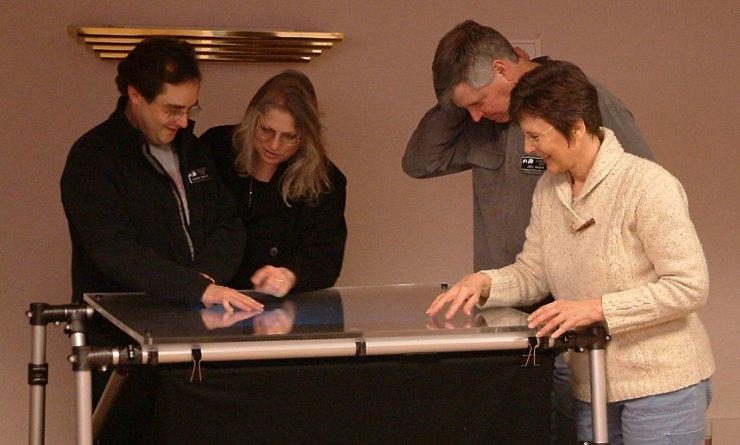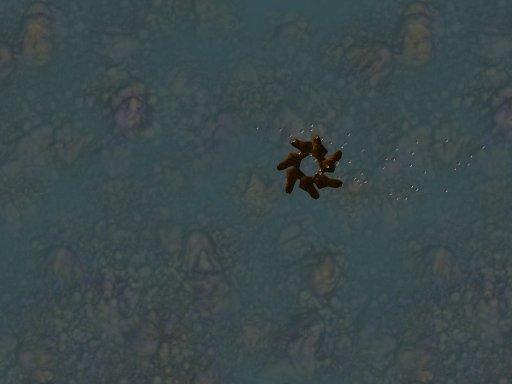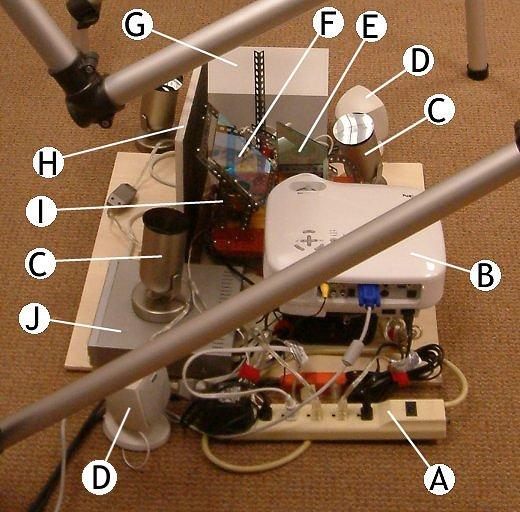The LAGOON OF TRANQUILITY saw its debut at the
2005 Contact Conference at
NASA Ames in Mountain View, CA. Participants were able to feed virtual
sea-creatures via an infrared-sensing tabletop. Creatures respond to the
release of food particles triggered by motion detected over the surface of
the tabletop.

Participants enjoying the "Lagoon of Tranquility"

Complete setup at the Contact art show

Typical tabletop projection image
The tabletop "Lagoon of Tranquility" exhibit was run by two PCs, and
a monitor near the exhibit displayed what the infrared camera was seeing.
The monitor displayed little sparkles where motion was being identified in
the image. It turned out that this display was nearly as fascinating
to the participants as the interactive display on the table itself.

"Behind the scenes" monitor of infrared activity
The skirt of the table was folded back at one corner so visitors could see what was
going on inside.

Visitors were allowed a peek at the innards
Construction Details:

A - Power connections
B - Projector
C - Infrared illuminators
D - Stereo speakers
E - First surface mirror
F - Cold mirror
G - Subwoofer
H - Reflection-blocking baffle
I - Infrared video camera
J - CD Player
Ambient sound for the exhibit was produced by a looped CD.
Future Directions/Issues:
The size of the projection on the tabletop didn't quite take full advantage of the
tabletop, due to the relatively short distance of projection. In fact, the tabletop
had to be adjusted several inches higher than the original target in order to produce
a sufficient image size. Some mirror bounce underneath the table was implemented in
an attempt to correct for this, but was limited by the restrictive size of the
cold mirror. One alternative might be to bounce off the cold mirror first, then off
a larger first-surface mirror. Positioning the mirrors was troublesome as well (yes,
that is an erector set construction that is supporting them).
The plexiglas top is quite shiny, and does present some reflection issues even
if there are no lights directly overhead. Some positions around the table were
affected by overhead lighting that was several feet outside the exhibit area.
An alternative could be to tilt the table more like an easel, but the horizontal
top as used here even with the reflection issues still provides for more simultaneous
users than an easel approach would allow.
Using the cold mirror as a "beam splitter" was very effective in removing
trapezoid distortion in the camera image, only simple scaling was necessary
to calibrate the camera coordinates to the display coordinates. The cold mirror
was an antique glass mirror made by Kodak for enlarger applications (used because
it was on hand), and did subtract a notable amount of visible red out of the
projection, a more modern substrate based mirror may be an improvement.
Sensitivity of the table was excellent, it was able to pick up any motions over
the projection that were anywhere within about 6 inches above the tabletop.
|
|
 II
II II
II